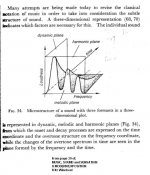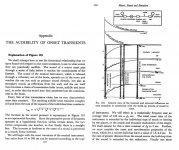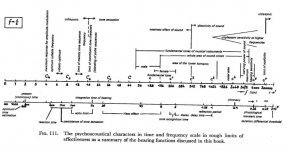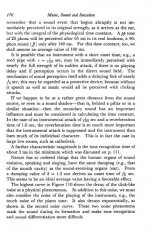Jan,
Just from that short little clip it would seem that we have our own global feedback network working between the brain and our ears!
Thanks for the clip.
Ohh yes definitely! The brain can selectively turn up or down the gain of elements in the hearing hardware to get a better 'fit' with what it 'thinks' it is hearing. Great survival tool on the savannah, and if you get it wrong, maybe you ran away one time too many, but no harm done!
jan
Attachments
Hoo, boy, you probably won't believe me, but I hadn't actually listened to those tracks while I was doing the resampling exercise. My laptop's sound is stuffed because of a silliness on my part some time ago with other gear, and I only just listened to the tracks mentioned, on the desktop PC ...What I've looked at so far is Haydn: String Quartet in D, Op. 76, No. 5 - Finale - Presto Engegårdkvartette, the 192 and 96 versions, which differed, wrongly IMO. Then, in the last round: B.Britten: Simple Symphony, Op. 4 - Boisterous Bourrée, TrondheimSolistene / Øyvind Gimse / Geir Inge Lotsberg / Anders Nilsson, here the 352.8 vs. the 96 examples. The latter has been badly resampled, or a different encoding method has been used...
The 352.8 track is stinking with ultrasonic rubbish, the waveform looks like you've got a nice little LC resonance in the neighbourhood, going along for a merry ride.
Frank
I wouldn't give you anything for the Britten tracks, 352.8 or 96, extremely dreary sound. Pretty savage equalising, or other intervention, took place -- all sparkle has been excised, why audiophile sound has such a bad reputation.
And the Haydn String Quartet? The manipulation to make sure the 192 version sounded better than the 96 is so extreme the people at 2L must be paranoid about people not getting it! If anyone here can't pick the differences on the most rubbishy setup I would be seriously worried about their ears ...
Frank
It may be that ALL sources in the known universe are so poor that Blowtorch ALWAYS sounds worse than evil 4558.

Why such BS?
Did you forget the studies about hf perception and preference?
It is lapalissian.
This is all rather misleading: Esperado is correct IN GENERAL, just like a car that is 10 years old or older should be replaced by another, just because it is just worn out.
However, my cars are 16 years and 29 years old, respectively, and drive pretty well. I have no need in replacing them, because one has only 30K miles, and the other 67K miles respectively, and that is an exception to the AVERAGE OPERATION of a typical automobile.
My alignment tapes will suffer somewhat, BUT I know how to store them and they have not been exposed to a temperature change or a strong magnetic field for at least the last 15 years. The most important use of them, however, will be for azimuth, because I have a calibrated wire loop for accurate reproduction adjustment. Please remember, I designed tape recorders as well as used them.
In Dave Wilson's case, all the tapes are made 30ips full track, so their losses, with care in storage, will be minimal. Also they used Scotch 250 or something similar and not AGFA, which had problems over time with the binding. Of course, the 45KHz of frequency response that Dave measured might drop to 30KHz or even slightly lower, but not even my critics can consider that to be audible in any case.
However, my cars are 16 years and 29 years old, respectively, and drive pretty well. I have no need in replacing them, because one has only 30K miles, and the other 67K miles respectively, and that is an exception to the AVERAGE OPERATION of a typical automobile.
My alignment tapes will suffer somewhat, BUT I know how to store them and they have not been exposed to a temperature change or a strong magnetic field for at least the last 15 years. The most important use of them, however, will be for azimuth, because I have a calibrated wire loop for accurate reproduction adjustment. Please remember, I designed tape recorders as well as used them.
In Dave Wilson's case, all the tapes are made 30ips full track, so their losses, with care in storage, will be minimal. Also they used Scotch 250 or something similar and not AGFA, which had problems over time with the binding. Of course, the 45KHz of frequency response that Dave measured might drop to 30KHz or even slightly lower, but not even my critics can consider that to be audible in any case.
John,
I don't understand how the fact whether a tape is 30ips or even 3 3/4 and four track has much to do with the print-through of tape signal from layer to layer after all these years? I do understand that if the tape has been wound without being extremely tightly wound would help in this regards and perhaps one tape type has better chemistry and the magnetic particles have not shed as much but isn't this and hasn't this always been a problem with master tapes since way before the advent of any other recording media? I still have an old Revox A77 sitting on the shelf and some very old tapes with just random music on them, I will have to take a listen to them and see how bad they have become. No the tapes were not in a temperature and humidity controlled room so this would be worst case I would say. And if I remember I only used 3M tape back in those days. I every once in awhile look at that old tape machine and wonder why it is still sitting there, what I will ever do with that thing?
I don't understand how the fact whether a tape is 30ips or even 3 3/4 and four track has much to do with the print-through of tape signal from layer to layer after all these years? I do understand that if the tape has been wound without being extremely tightly wound would help in this regards and perhaps one tape type has better chemistry and the magnetic particles have not shed as much but isn't this and hasn't this always been a problem with master tapes since way before the advent of any other recording media? I still have an old Revox A77 sitting on the shelf and some very old tapes with just random music on them, I will have to take a listen to them and see how bad they have become. No the tapes were not in a temperature and humidity controlled room so this would be worst case I would say. And if I remember I only used 3M tape back in those days. I every once in awhile look at that old tape machine and wonder why it is still sitting there, what I will ever do with that thing?
My favorite tape, at this time, was Ampex 456 ! :-( lAlso they used Scotch 250 or something similar and not AGFA, which had problems over time with the binding.
A real nightmare ! They all need to be baked.
Last edited:
If I recall well it was acetylcellulose that was more durable (less glueing and echoes), but unfortunately less soft surface and more crisp.
Magnetbandmuseum - Sie sind im Bereich: Die Magnetband Story ab 1900
Magnetbandmuseum - Sie sind im Bereich: Die Magnetband Story ab 1900
And this is why I will never 'fear' you Demian. '-)
I wouldn’t like to sound edgy in my first 2013 comment.
Demian was generous enough to credit the researchers and kind enough to warn us against unfounded generalisations. ( Psychoacoustics: Facts and Models - Hugo Fastl, Eberhard Zwicker - ?????? Google )
Thank you Demian.
The “feary” guys may make their way through artificial smoke [like in the quote below (my hifhlights)] and excite the ones who are willing to be excited
A CD player, amplifier, speaker and cables were described as a problem system. Conspirator - culprits were a foil wound inductor in the speaker, torroid power transformer in the amplifier, and voltage regulator at the player. Such parts could have been good choices, but in this circumstance, an RF short or near zero impedance inherent from the speaker inductor and choice of speaker cable had initiated detrimental switching activity or "circuit rattling" from the amplifier. "Fuzzy" distortion might be heard. Scope traces revealed frantic millionths of second activity along with high frequency pulses that propagated through the power transformer to end up between power and signal connectors. In this example, disturbances passed through interconnect wires and on to player circuits to increase clock jitter and degrade signal accuracy.
Different power cords and their placement would modify path responses thereby changing disturbance at the player. Possibly one wire might sound different from another but the best solution was to fix the design problem. Then cords and interconnects were no longer an issue.
The quote was from the link kindly provided by Dimitri
Prof. Keith O. Johnson's Comments on His Measurements and Graphs | Stereophile.com
Frequency and time are conjugate variables. Pick one.
No. I refuse to pick just one...
Time, as in group delay...
Time as an element of sound onset development (see attachment)
George
Attachments
George,
As always you seem to have the right references at the right time. You must have one hell of a library and indexing system to get to the point so fast. Makes me think that I am going in the correct direction with my thinking and the mechanical and electrical responses needed to accurately reproduce those high frequency sounds and all the rest of the bandwidth.
Thanks again and a Happy New Year to you.
As always you seem to have the right references at the right time. You must have one hell of a library and indexing system to get to the point so fast. Makes me think that I am going in the correct direction with my thinking and the mechanical and electrical responses needed to accurately reproduce those high frequency sounds and all the rest of the bandwidth.
Thanks again and a Happy New Year to you.
John,
My take on success in the audiophile market is the main component is the marketing dollars needed to make yourself known and the quality of the ad type, not always a superior product. As a matter of fact some of the high dollar product is utter non-sense to say the least. That brings $100,000 loudspeakers to mind when all the devices are off the shelf devices except for cosmetic changes. You can sell anything if the buyer is vain enough to want to show off their wealth.
My take on success in the audiophile market is the main component is the marketing dollars needed to make yourself known and the quality of the ad type, not always a superior product. As a matter of fact some of the high dollar product is utter non-sense to say the least. That brings $100,000 loudspeakers to mind when all the devices are off the shelf devices except for cosmetic changes. You can sell anything if the buyer is vain enough to want to show off their wealth.
No, PMA, ALL are important. I may be luckier than many here, including you, because I have earned a reputation of audio design since the Levinson days in the early 1970's, but IF I don't make a really GREAT product, I will suffer, perhaps more silently compared to others, but our sales and reviewer rating will fail to materialize. Trust me.
PMA, I consider you an excellent engineer, as well as does Ed Simon. Just keep cutting at it, perhaps with someone with more essential ability to promote your product. I am SURE that locally, at least, you can beat us all in cost effective and QUALITY design. Just don't be TOO cost effective and presume that something that perhaps I might consider important is not important enough to do. Please remember you have to establish your reputation first, before you can see what you might be able to get away with, (like my Para. JC-3), and even the JC-3 is far more sophisticated than many realize.
PMA, I consider you an excellent engineer, as well as does Ed Simon. Just keep cutting at it, perhaps with someone with more essential ability to promote your product. I am SURE that locally, at least, you can beat us all in cost effective and QUALITY design. Just don't be TOO cost effective and presume that something that perhaps I might consider important is not important enough to do. Please remember you have to establish your reputation first, before you can see what you might be able to get away with, (like my Para. JC-3), and even the JC-3 is far more sophisticated than many realize.
Demian and I are having a personal dialogue about the nature of what is necessary to be successful in audio design. It is not about engineering.
Mr. Curl
My Wishes for a Good New Year.
I may not read your post properly but it seems to me that you make a point on segregating engineering from audio design (I intentionally don’t pay any attention to the “successful” adjective) and neglecting at the same time the importance of psychoacoustics research findings on the audio design methodology
Although totally unimportant to anyone here, I find no rational in that route.
George
Engineering is great! Wonderful! So is Physics! But true success needs more than JUST engineering and physics. The only way that I know to get it right is to apply what listening experience with passive components and quality layout can give to 'improve' the design to sound its best.
George,
Steven
My wishes to you too.
My “library” is very small and the “indexing system” is my queer photographic memory (“I know I’ve seen it somewhere”
I too consider as a most important goal to preserve the onset and decay of musical instruments “attack” as much as unaltered throughout the equipment chain.
The form of these transients though, do change through the air travel in the acoustic space and their perception image is affected by that space.
On this, four more pages from the same book (data is from 1960)
George
Attachments
We made it! After the Mayan prediction, now we wait for the big earthquake! '-)
Hi John,
It isn't Mayan prediction, it's a wrong interpretation of the reason Mayan Calendar ended on December 2012. The Mayan didn't say the world will end, only their Calendar which was found stretched only up to December 2012.
That aside, it seems to me that our world on planet Earth isn't the best of all worlds, it is far from it. Only, I have no clue about how to amend, or improve it.
- Status
- Not open for further replies.
- Home
- Member Areas
- The Lounge
- John Curl's Blowtorch preamplifier part II




